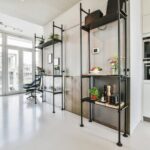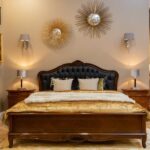Are you ready to transform your living space into a reflection of your personal style? In this article, we will show you how to be your own home decorator, allowing you to create a space that truly feels like home.
Decorating your home is more than just arranging furniture and selecting paint colors. It’s about creating an environment that reflects your personality and brings you joy every time you walk through the door. By taking on the role of your own decorator, you have the power to design a space that aligns with your unique taste and lifestyle.
In the following sections, we will guide you through the process of finding your style, budgeting for decor, planning room layouts, incorporating color and pattern, tackling DIY projects, accessorizing with flair, and seeking out inspiration and resources. With our tips and advice, you’ll be well-equipped to become your own home decorator and create a space that is both beautiful and functional. So let’s get started on this exciting journey of transforming your living space.
Finding Your Style
When it comes to home decor, one of the most important steps is identifying your personal design preferences and aesthetic. This will help you create a space that truly reflects your personality and makes you feel at home. There are a few key tips to keep in mind when trying to pinpoint your style.
First, take the time to look for inspiration. This can be done through various sources such as magazines, online platforms, or visiting furniture stores. Pay attention to the styles, colors, and textures that catch your eye and make you feel comfortable. Creating a mood board or Pinterest board can also be helpful in visually organizing your preferences.
Secondly, consider the architecture of your home. Is it modern, traditional, minimalist, or eclectic? Your personal style should complement the existing architectural elements of your space. For example, if you have a historic home with intricate moldings and details, you may lean towards a more classic and vintage-inspired decor style.
Lastly, don’t be afraid to mix different styles. You can create an eclectic space by combining various design elements from different time periods and aesthetics. The key is finding a balance and creating cohesion within the mix of styles.
Budgeting for Decor
Budgeting for home decor is an important aspect of being your own decorator. Setting a budget allows you to prioritize your spending and find affordable options that align with your personal style and aesthetic. By following some simple strategies, you can create a beautiful and stylish space without breaking the bank.
Assess Your Priorities
Before embarking on any home decor project, it’s crucial to assess your priorities and determine which areas of your home are in most need of attention. Whether it’s revamping the living room, upgrading your bedroom decor, or simply adding some personal touches to the kitchen, identifying these priorities will help you allocate your budget more effectively.
Shop Smart
When it comes to finding affordable decor options, there are plenty of smart shopping strategies to keep in mind. Consider frequenting thrift stores and local flea markets for unique and budget-friendly finds. Additionally, keep an eye out for sales at larger retailers or online marketplaces where you may be able to snag high-quality items at discounted prices. Another cost-effective option is to DIY certain decor pieces rather than purchasing them at full price.
Set a Realistic Budget
Setting a realistic budget is key to successfully decorating your home without overspending. Take into account both large and small expenses when creating a budget, from furniture and paint to smaller accents like throw pillows or artwork. By setting clear budget limits for each category and sticking to them, you can ensure that you stay within your means while still achieving the desired look for your space.
Room Layout and Flow
Consider the Function of the Room
Before arranging furniture, it’s crucial to consider the primary function of the room. For example, if you’re working on a living room, think about how you plan to use the space – whether it’s for entertaining guests, watching television, or simply relaxing. Understanding the intended purpose will help you determine the most practical layout for your furniture.
Create a Focal Point and Balance
A well-designed room typically features a focal point that draws attention and creates visual interest. This could be a fireplace, a piece of art, or a statement piece of furniture. Once you’ve identified the focal point, arrange your furniture around it in a way that achieves balance and harmony. Avoid placing all your furniture against the walls; instead, aim for an arrangement that encourages conversation and traffic flow.
Maximize Space With Smart Storage Solutions
In smaller rooms or homes with limited storage, it’s essential to maximize space while maintaining an organized and clutter-free environment. Consider incorporating multi-functional furniture pieces such as ottomans with hidden storage or wall-mounted shelves. Additionally, investing in storage solutions like baskets and bins can help keep items neatly stowed away while adding to the overall aesthetic of the room.
By following these tips for arranging furniture and creating a cohesive layout, you can transform your living space into a stylish and functional environment that reflects your personal taste and lifestyle.
Color and Pattern
In addition to choosing colors, patterns also play a crucial role in home decor. Whether it’s through the use of wallpaper, curtains, rugs, or throw pillows, incorporating different patterns adds depth and personality to a room. When working with patterns, it’s important to consider scale and proportion. Mixing various scales of patterns can create an eye-catching effect, while ensuring that they complement each other is key to achieving a balanced look.
Furthermore, when decorating with color and pattern, it’s essential to take into account the natural light in each room. Bright colors and bold patterns work well in well-lit spaces, while softer tones or subtle patterns are better suited for rooms with less natural light. Understanding these nuances will allow you to make more informed decisions when using color and pattern to enhance your home decor.
| Element | Description |
|---|---|
| Color Palette | Choosing primary colors and complementary or contrasting hues. |
| Patterns | Incorporating depth and personality through various patterns |
| Natural Light | Considering the impact of natural light on color and pattern choices. |
DIY Projects
Decorating your home doesn’t have to break the bank. In fact, there are plenty of simple and cost-effective DIY projects that can add a personal touch to your space without costing a fortune. Whether you’re looking to add custom art, create unique storage solutions, or simply update existing furniture, there are endless possibilities for DIY home decor.
To get started with your DIY projects, consider the following ideas:
- Create custom artwork: Use inexpensive materials such as canvas, paint, and stencils to create one-of-a-kind art pieces for your walls.
- Upcycle old furniture: Give new life to outdated furniture with a fresh coat of paint or new hardware. You can also repurpose old items into new and useful pieces.
- Personalize accessories: From throw pillows to picture frames, consider embellishing store-bought items with fabric, trim, or personalized details to match your decor style.
Not only can DIY projects save you money, but they also allow you to infuse your personality into every corner of your home. With a little creativity and some basic supplies, you can easily personalize your space in a way that reflects your unique style and tastes.
Whether you’re an experienced crafter or just starting out, there are DIY projects for every skill level. So roll up your sleeves and get ready to transform your home with these budget-friendly decor ideas.
Accessorizing
When it comes to accessorizing your home, the right decor can make a significant impact on the overall look and feel of a room. Here are some tips for choosing and arranging accessories to add personality and style to your living space:
- Consider the scale: When choosing accessories, it’s important to consider the scale of the room and the furniture. Avoid overwhelming a small space with oversized accessories, and fill up larger rooms with a mix of larger and smaller pieces.
- Layer different textures: Adding variety in texture can bring depth and interest to a room. Mix materials like wood, metal, glass, and fabric to create visual contrast and tactile appeal.
- Showcase personal items: Accessories are a great way to display your personality and interests. Consider incorporating personal items such as family photos, travel souvenirs, or sentimental objects into your decor.
Accessorizing is an opportunity to infuse character into your home while tying together the various design elements in a room. By carefully curating accessories that resonate with you, you can add warmth and personality to any space.
Finding unique pieces can be done through various channels such as thrift stores, antique shops, or online marketplaces. Additionally, exploring platforms like Pinterest or design blogs can provide ample inspiration for accessorizing your home. Whether you prefer minimalist decor or bohemian accents, there are endless possibilities for creating a personalized and stylish atmosphere in your living spaces.
Resources and Inspiration
In conclusion, becoming your own home decorator can be a rewarding and fulfilling experience. By taking the time to identify your personal style, set a budget, and explore various design elements such as layout, color, and DIY projects, you can create a space that truly reflects your personality and taste. Additionally, utilizing online resources and design blogs can provide endless inspiration and access to affordable decor options.
One of the key benefits of being your own home decorator is the ability to create a space that feels truly unique and personalized. By finding inspiration from online platforms and design blogs, you can discover new ideas and trends to incorporate into your home decor. Whether it’s through social media platforms like Instagram or Pinterest, or by following your favorite interior design bloggers, there are countless sources of inspiration at your fingertips.
Furthermore, by taking on the role of your own home decorator, you have the opportunity to continually evolve and update your space as your tastes change over time. With the abundance of resources available online, you can stay informed about the latest trends and techniques in home decor, allowing you to adapt and refresh your living environment as needed.
Ultimately, becoming your own home decorator empowers you to create a space that is not only beautiful but also truly reflective of who you are.
Frequently Asked Questions
How Do I Become a Personal Decorator?
Becoming a personal decorator usually starts with gaining education and experience in interior design or a related field. Many personal decorators have a degree in interior design or a certification in decorating.
Building a portfolio of your work is also important, as it showcases your skills to potential clients. Network with people in the industry and consider working for a firm or gaining experience under an established personal decorator to build your expertise.
How Do I Start My Own Interior Decorating Business?
Starting your own interior decorating business requires careful planning and consideration of several key factors. Begin by researching the market demand for interior decorating services in your area and defining your target audience. Develop a clear business plan that outlines your services, target market, pricing structure, and marketing strategies.
Obtaining any necessary licenses or certifications is also crucial before officially launching your business. Networking within the design community and building strong relationships with suppliers can also help establish and grow your business.
How Do I Start My Own Home Design Business?
Starting a home design business involves similar steps to starting an interior decorating business but with added considerations specific to architectural design and construction. Aspiring home designers typically need formal education and experience in architecture or architectural design, as well as proficiency in computer-aided design (CAD) software.
Building a portfolio of your designs is essential for showcasing your skill set to potential clients. Additionally, networking with contractors, real estate agents, and other industry professionals can help you establish yourself in the field and attract clients seeking home designs for new construction or remodeling projects.

I’m thrilled to be your companion on this exciting journey through the world of home decor and design. With a passion for turning houses into homes and a keen eye for the finer details, I’m here to help you transform your living spaces into beautiful, functional, and meaningful havens.





